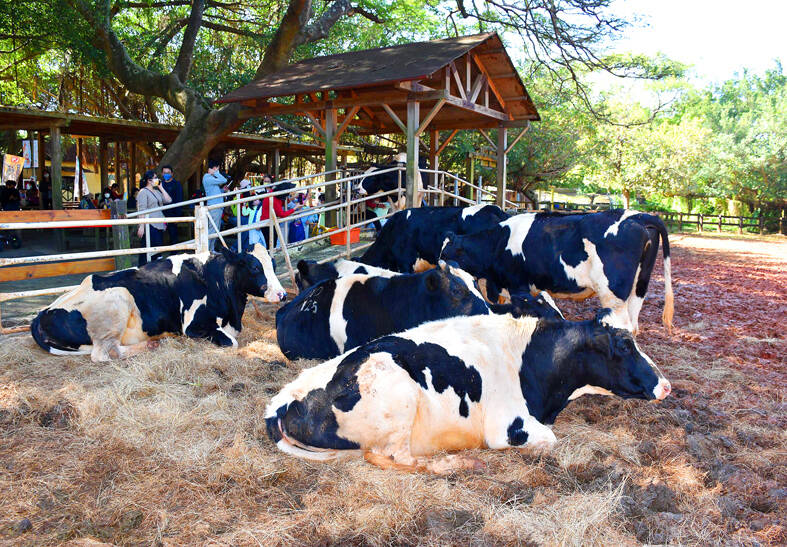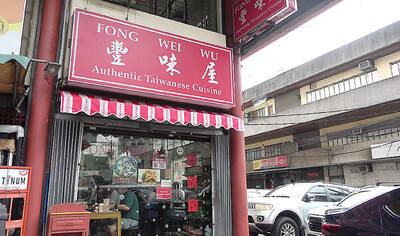The Council of Agriculture said it is developing isotope distinguishment technology, which, combined with “big data,” would differentiate the production location of dairy products.
The plan was made due to concerns about the impending removal of tariffs for Taiwanese imports of New Zealand beef, lamb and dairy products — as a result of the Agreement Between New Zealand and the Separate Customs Territory of Taiwan, Penghu, Kinmen and Matsu on Economic Cooperation (ANZTEC) — would significantly affect domestic dairy and meat markets, the council said.
ANZTEC, signed in 2013, removed tariffs on a set amount of liquid dairy products — 5,500 tonnes as of 2013 — and adds a charge of NT$14 for every kilogram exceeding that amount.

Photo: Lee Jung-ping, Taipei Times
It was agreed that the allocated amount of tariff-free products would increase by 1,500 tonnes every three years until 2025, when quotas would be removed.
As of last month, Taiwan has imported 103,562 tonnes of dairy products, a 9.2 percent increase compared with the same period last year, the council said.
It also said it plans to encourage domestic dairy quality, match domestic dairy production to market needs and step up measures to distinguish local and imported dairy products.
Over the past decade, domestic dairy production has increased from 320,000 tonnes to 430,000 tonnes, the council said.
Due to high domestic demand, dairy farmers have been known to produce amounts exceeding the quota, and contracted processing companies have been more than willing to purchase the excess, it said.
However, as the domestic dairy market is becoming saturated and the nation’s economic environment is causing public spending to turn conservative, processing companies are demanding that dairy producers observe the output quotas.
There are standard certifications for milk, but they could be improved to differentiate local and imported dairy products, the council said, adding that it is developing a system to do so.
The council said that the system, which has been trialed for two years, has a 90 percent accuracy rate in differentiating the origin country of dairy products, and it can also determine whether milk is fresh or made from powder.
The system is almost complete, and can be used to inspect pork and chicken meat to identify the country of origin, it said, adding that Taiwan would provide product origin information on packaging.

The Ministry of Foreign Affairs (MOFA) yesterday voiced dissatisfaction with the Comprehensive and Progressive Agreement for Trans- Pacific Partnership (CPTPP), whose latest meeting, concluded earlier the same day, appeared not to address the country’s application. In a statement, MOFA said the CPTPP commission had "once again failed to fairly process Taiwan’s application," attributing the inaction to the bloc’s "succumbing to political pressure," without elaborating. Taiwan submitted its CPTPP application under the name "Separate Customs Territory of Taiwan, Penghu, Kinmen and Matsu" on Sept. 22, 2021 -- less than a week after China

ALIGNED THINKING: Taiwan and Japan have a mutual interest in trade, culture and engineering, and can work together for stability, Cho Jung-tai said Taiwan and Japan are two like-minded countries willing to work together to form a “safety barrier” in the Indo-Pacific region, Premier Cho Jung-tai (卓榮泰) yesterday said at the opening ceremony of the 35th Taiwan-Japan Modern Engineering and Technology Symposium in Taipei. Taiwan and Japan are close geographically and closer emotionally, he added. Citing the overflowing of a barrier lake in the Mataian River (馬太鞍溪) in September, Cho said the submersible water level sensors given by Japan during the disaster helped Taiwan monitor the lake’s water levels more accurately. Japan also provided a lot of vaccines early in the outbreak of the COVID-19 pandemic,

A home-style restaurant opened by a Taiwanese woman in Quezon City in Metro Manila has been featured in the first-ever Michelin Guide honoring exceptional restaurants in the Philippines. The restaurant, Fong Wei Wu (豐味屋), was one of 74 eateries to receive a “Michelin Selected” honor in the guide, while one restaurant received two Michelin stars, eight received one star and 25 were awarded a “Bib Gourmand.” The guide, which was limited to restaurants in Metro Manila and Cebu, was published on Oct. 30. In an interview, Feng Wei Wu’s owner and chef, Linda, said that as a restaurateur in her 60s, receiving an

Kaohsiung Mayor Chen Chi-mai (陳其邁) on Monday announced light shows and themed traffic lights to welcome fans of South Korean pop group Twice to the port city. The group is to play Kaohsiung on Saturday as part of its “This Is For” world tour. It would be the group’s first performance in Taiwan since its debut 10 years ago. The all-female group consists of five South Koreans, three Japanese and Tainan’s Chou Tzu-yu (周子瑜), the first Taiwan-born and raised member of a South Korean girl group. To promote the group’s arrival, the city has been holding a series of events, including a pop-up